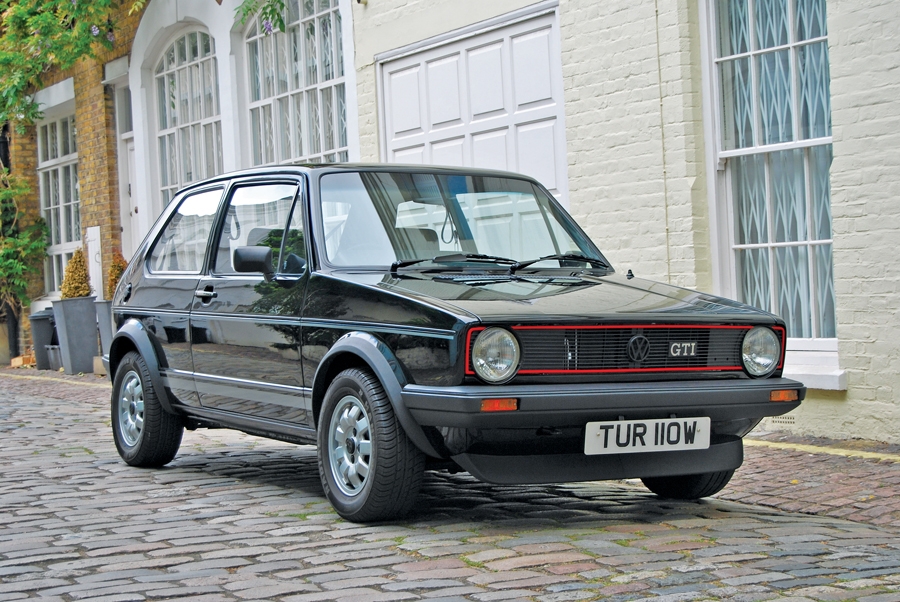
By 1970, Volkswagen’s “People’s Car,” the venerable Type 1 Beetle, was long in the tooth. The company knew it was time for a successor — something cleaner than the stinky old air-cooled model, with a modern body design. The company got to work on a new project called the Type 17.
The new car used a transverse engine and front-wheel-drive layout borrowed from VW’s Audi subsidiary, and Italdesign Giugiaro provided the bodywork for an attractive compact hatchback car.
Most of the world was introduced to the new car as the Golf in 1974, while in the U.S., it was sold as the 1975 Rabbit. The first editions carried a 1.5-liter carbureted engine good for 70 horsepower mated to a 4-speed transmission. That didn’t change much until the arrival of the sporty GTI, first shown at the Frankfurt Auto Show in 1975 and available to most world markets as a 1976 model.
The I in GTI has always stood for “injection.” The first cars used a 1.6-liter single overhead-cam engine fitted with Bosch K-Jetronic fuel injection. That package was rated at 110 horsepower and 103 pound-feet of torque. Backing that up was a 5-speed transmission filled with a wide-ratio gear set.
The hot hatch comes to America
Canadian buyers got the GTI in 1979, but Americans didn’t get a crack at it until 1983. In the U.S, the Rabbit GTI sported a 1.8-liter engine that made 90 horsepower and 105 pound-feet of torque. The 5-speed transmission was upgraded with a close-ratio gear set, and the GTI included newly upgraded suspension with performance-oriented spring rates, upgraded sway bars and ventilated front disc brakes. GTI models also received alloy wheels and a better interior than standard-run models.
Just two years of production — 1983 and 1984 — were sold in the United States before the Mk I platform transitioned to the Mk II and the nameplate was changed to Golf GTI.
European-spec Mk I GTIs have a small advantage over U.S. cars thanks to their slightly lighter weight and attractive Euro bumpers in place of the clunky and overbuilt DOT units. The hotter 1.6-liter engine of the world-market cars is also attractive.
The Rabbit/Golf platform (and its extended family) quickly became an enthusiast favorite in America, with an impressive racing history. Because VW products were generally more affordable than the more upscale European sport sedans, the cars became popular with young people and have stayed that way. Most of the basic Rabbits have long since found the junkyard, but one of the the 30,000 GTI models built in Westmoreland, PA, can still be found without even looking too hard.
A good example
In early September, Bonhams sold a clean 1981 Golf GTI in Beaulieu for $25,514, including buyer’s premium. As a U.K.-delivery car, it was right-hand drive. It was apparently in top condition, with relatively low mileage, plenty of proven maintenance and had a complete rebuild with new wiring in 2006.
Most GTIs from this era, at least here in the U.S, continue to trade at or below $6,000, so the Bonhams price was a new high-water mark for the breed. The highest sale previously recorded for one of these was $18,859 in 2009 (SCM# 154514) for a 1984 U.S.-spec car with just 517 miles from new.
Get yours now
As the generation that loved GTIs when they were new becomes more active in the collector car market, these water-cooled sporty VWs are gaining more stature as collectibles. Prices are rising, so interested collectors will want to keep a keen eye open for good examples.
Because GTIs have been a favorite of boy racers for over 30 years, many cars have been molested or “upgraded” with later engines. Crash damage is also ubiquitous. Finally, as inexpensive hot rods, many or most of these cars have been stored outside over the decades. Rust issues are common around windows and in the engine compartment, and depending on how extensive it is, that rust can be quite difficult — and expensive — to fix.
But while really good GTIs might be rare both in the U.S. and overseas, they are out there. If you can find one of them, the time to buy is now. ♦
